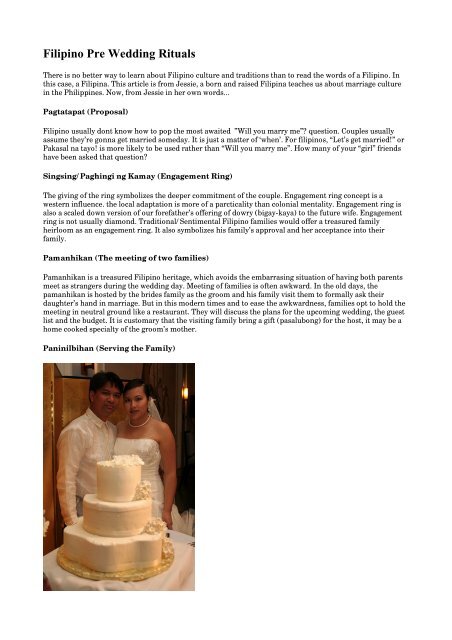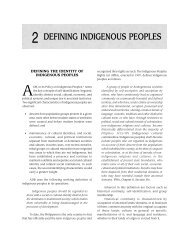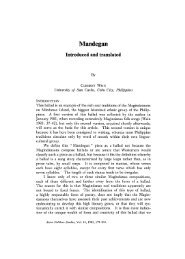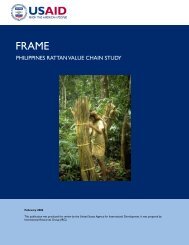Filipino Pre Wedding Rituals - Philippine Culture
Filipino Pre Wedding Rituals - Philippine Culture
Filipino Pre Wedding Rituals - Philippine Culture
You also want an ePaper? Increase the reach of your titles
YUMPU automatically turns print PDFs into web optimized ePapers that Google loves.
<strong>Filipino</strong> <strong>Pre</strong> <strong>Wedding</strong> <strong>Rituals</strong>There is no better way to learn about <strong>Filipino</strong> culture and traditions than to read the words of a <strong>Filipino</strong>. Inthis case, a Filipina. This article is from Jessie, a born and raised Filipina teaches us about marriage culturein the <strong>Philippine</strong>s. Now, from Jessie in her own words…Pagtatapat (Proposal)<strong>Filipino</strong> usually dont know how to pop the most awaited ”Will you marry me”? question. Couples usuallyassume they’re gonna get married someday. It is just a matter of ‘when’. For filipinos, “Let’s get married!” orPakasal na tayo! is more likely to be used rather than “Will you marry me”. How many of your “girl” friendshave been asked that question?Singsing/Paghingi ng Kamay (Engagement Ring)The giving of the ring symbolizes the deeper commitment of the couple. Engagement ring concept is awestern influence. the local adaptation is more of a parcticality than colonial mentality. Engagement ring isalso a scaled down version of our forefather’s offering of dowry (bigay-kaya) to the future wife. Engagementring is not usually diamond. Traditional/Sentimental <strong>Filipino</strong> families would offer a treasured familyheirloom as an engagement ring. It also symbolizes his family’s approval and her acceptance into theirfamily.Pamanhikan (The meeting of two families)Pamanhikan is a treasured <strong>Filipino</strong> heritage, which avoids the embarrasing situation of having both parentsmeet as strangers during the wedding day. Meeting of families is often awkward. In the old days, thepamanhikan is hosted by the brides family as the groom and his family visit them to formally ask theirdaughter’s hand in marriage. But in this modern times and to ease the awkwardness, families opt to hold themeeting in neutral ground like a restaurant. They will discuss the plans for the upcoming wedding, the guestlist and the budget. It is customary that the visiting family bring a gift (pasalubong) for the host, it may be ahome cooked specialty of the groom’s mother.Paninilbihan (Serving the Family)
Paninilbihan is a tradition wherein the soon-to-be-groom would perform chores to show his worth andresponsibility to the bride’s family. In the old days, the guy would chop wood (pagsibak ng kahoy) or fetchwater (pag-igib ng tubig) for the girls family. Some would say it is a dying tradition. But this ritual is stillsubconsciously practiced. The guy would replace a busted light, do a little carpentry work, drive the girl’smother to the supermarket and some other small errands for her family. The bride would also do the samefor his family, she would usually wash the dishes after dinner, cook or help clean the house.Pa-alam (Inform the family)Pa-alam is a appreciated by the <strong>Filipino</strong> elders as a sign of respect. The practice is a round of diplomatic visitsor courtesy calls to the people who matters most to the couple. Like the Grandparents, Aunts and Uncles ofboth parties. The spouse-to-be is introduced to them and formally telling them of the upcoming and weddingand ask for their blessings. It is best to do this at a family gathering to save trips and to hand out the weddinginvitations. The soon-to-be-weds also visits their prospective ninongs and ninangs (principalsponsor/godparents) for their wedding. And it is also customary to bring them a little something(pasalubong).Dulog (Meeting the “Father”)The term “dulog” literally means “approach”. This is the time for the soon-to-be-weds to approach theirparish priest for a meeting. Dulog is also called <strong>Pre</strong>-Nuptial interview. It is also a church requirementwherein the priest discusses with the couple of their duties and responsibilities as husband and wife. It alsoserves as a purpose of finding and possible problems and to determine the couples readiness and knowledgeof the doctrince of a Catholic marriage. It is also a good time to ask the priest anything related to the churchwedding. Despedida de Soltera (Bachelorette party) Despedida de Soltera is a send-off party hosted by herfamily held close to the wedding date in honor of the bride-to-be. The groom ad his family, the weddingentourage, close friends and relatives from both sides are all invited to meet and to get to know anotherbefore the wedding day. It is also a formal introduction of both parties to each other.Alay-Itlog kay Sta. Clara (Offering eggs to St. Claire)St. Claire (Sta. Clara) has long been considered the patron saint of good weather. Clara means clear inspanish. And where does the egg comes in to play? Clara de huevo is spanish for egg white. Despite its paganorigins, marrying Catholic Pinoys offer eggs and prayers to the patron saint of good weather that theirwedding day would be rain-free. Eventhough, Rain showers on a wedding day is believed to bring bountifulblessings to the newly weds, but others still prefer a clear and sunny wedding.Kasal-Kumpisal (confessions)It is a moral obligation required by the Church of marrying Catholic couple days prior to the wedding to havetheir final confessions with a priest. It also serves as a spiritual cleansing for the sins committed prior to theSacrament of Marriage and a commitment and devotion to one’s partner.Ref.: http://cebuexperience.com/living-in-the-philippines/filipino-culture/9-filipino-pre-weddingrituals/

















